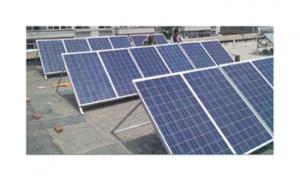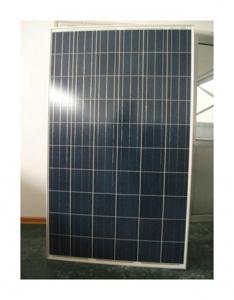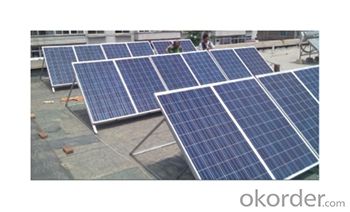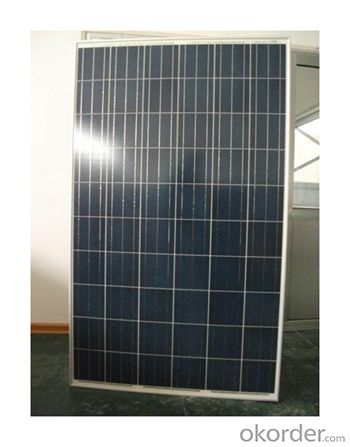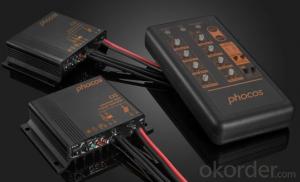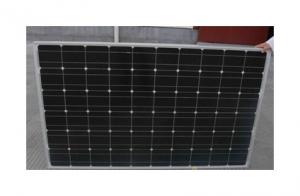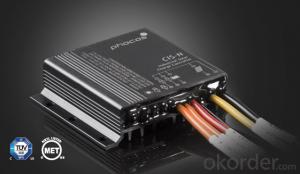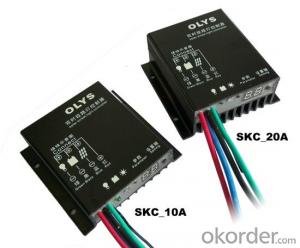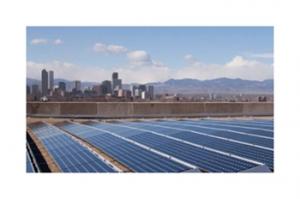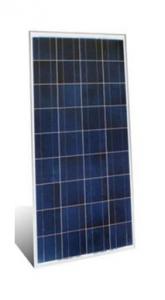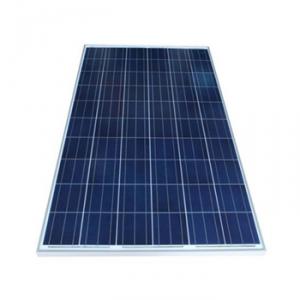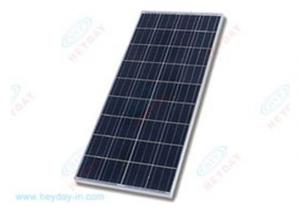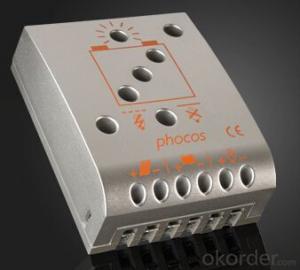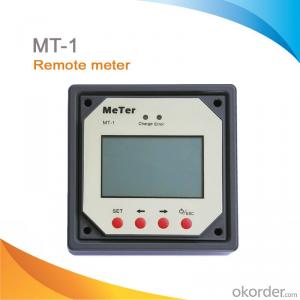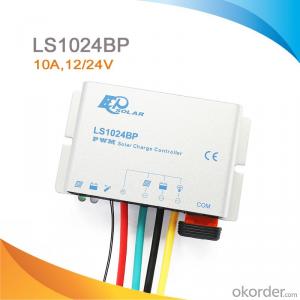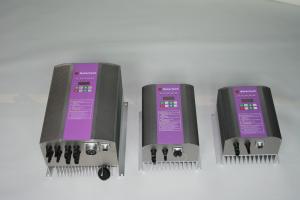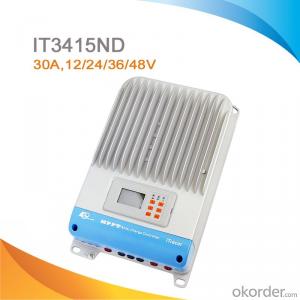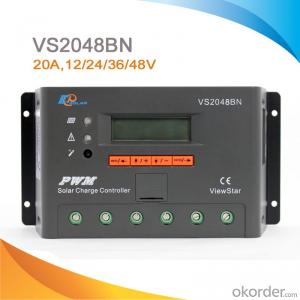OEM Solar MPPT Charge Controllers for Poly-Crystalline 230W 156*156 Solar Modules
OKorder Service Pledge
OKorder Financial Service
You Might Also Like
Solar Module Descriptions:
Solar Power Modules (known as Photovoltaics - PV) can generate electricity for your home or business, either as part of a stand-alone solar power system, or for buildings already connected to the local electricity network.
PV systems use the most abundant energy source on the planet, solar radiation, to generate electricity. They are silent, consume no fuel and generate no pollution. They also contribute to the reduction of greenhouse gas emissions; a 2kW PV system on a house will prevent the emission of about 40 tonnes of CO2 during its projected 30 year lifetime. Furthermore, the use of PV will reduce your electricity bills and exposure to fluctuating and steadily rising electricity prices.
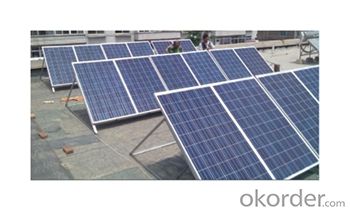
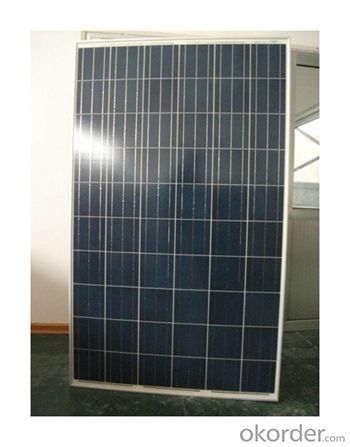
Electrical Characteristics
Max-power (W) | 230 |
Max-Power Voltage (V) | 29.50 |
Max-Power Current (A) | 7.80 |
Open-Circuit Voltage (V) | 36.80 |
Short-Circuit Current (A) | 8.28 |
Mechanical Characteristics
Cable type, Diameter and Length | 4mm2, TUV certified, 1000mm |
Type of Connector | Compatible with MC4 plug |
Arrangement of cells | 6*10 |
Cell Size | 156*156 |
Dimension | 1580*1069*45 |
Weight | 19.5Kg |
Glass, Type and Thickness | High Transmission, Low Iron, Tempered Glass 3.2mm |
Features
Guaranteed positive tolerance 0/+5w ensures power output reliability
Strong aluminum frames module can bear snow loads up to 5400Pa and wind loads up to 2400Pa.
Excellent performance under low light environments (mornings evenings and cloudy days)
12 years for product defects in materials and workmanship and 25 years for 80% of warranted minimum power.
Certifications and standards: IEC 61215.
Manufactured according to International Quality and Environment Management System (ISO9001, ISO14100).
FAQ
Q: What kind of loads can I run on PV?
With a correctly designed PV system you can power almost any electrical load. However, as the load size increases the expense also increases. Loads like hot water heaters, air conditioners, room heaters and electric stoves should be avoided. The added cost of trying to power loads like these is very cost prohibitive. If these loads have to be powered it will be a lot less expensive to change the appliance to use an alternative fuel type like propane.
Q: What is PV & how does it work?
PV stands for photovoltaic. Photo = Light and Voltaic = Electricity. A solar cell converts light to electricity.
A solar cell is made of silicon. Computer chips are made of this same material. Basically, when light strikes the surface of a solar cell some of it is absorbed into the silicon. This light energy bumps the electrons loose and causes energy to flow.
By packaging approximately 36 solar cells together a solar panel or a solar module is created. When you have more then one solar panels you create a solar array.
- Q: What is the maximum cable size that can be used between the solar panels and the solar controller?
- Various factors, such as the distance between the solar panels and the solar controller, the current capacity of the panels, and the limitations on voltage drop, influence the maximum cable size that can be used. It is generally recommended to use larger cable sizes to minimize voltage drop and ensure efficient power transmission. To determine the maximum cable size, one must consider the cable's current carrying capacity and the voltage drop over the distance. The manufacturer typically defines the current carrying capacity, which can be found in the cable specifications. It is crucial to select a cable capable of handling the maximum current generated by the solar panels. Voltage drop is another crucial factor to consider. It occurs due to the cable's resistance and can impact the overall performance and efficiency of the solar system. The acceptable voltage drop varies depending on the system's requirements, but a general guideline is to keep it below 3% for optimal performance. To calculate the maximum cable size, one can use the voltage drop formula and the cable's current capacity. By considering the distance between the panels and the controller, the current generated by the panels, and the acceptable voltage drop, one can determine the appropriate cable size. For specific solar panels and controllers, it is advisable to consult with a professional or refer to the manufacturer's guidelines. They can provide accurate recommendations based on the system's requirements and ensure the optimal cable size is chosen for maximum performance and safety.
- Q: Can a solar controller be used with a solar-powered ventilation system?
- Yes, a solar controller can be used with a solar-powered ventilation system. A solar controller helps regulate the charging and discharging of batteries in a solar system, ensuring efficient use of solar energy. In the case of a solar-powered ventilation system, the solar controller can help manage the power supply to the system, ensuring optimal performance and extended battery life.
- Q: Can a solar controller be used with solar-powered indoor vertical farming systems?
- Yes, a solar controller can be used with solar-powered indoor vertical farming systems. Solar controllers are designed to regulate and optimize the flow of electricity from solar panels to the connected devices or systems, such as indoor vertical farming systems. By effectively managing the charging and discharging of batteries and ensuring a stable power supply, a solar controller can help maintain the proper functioning of the indoor vertical farming system even without direct access to traditional power sources.
- Q: How does a solar controller handle load control and diversion charging?
- Load control and diversion charging are managed by a solar controller, which utilizes its built-in features and capabilities. To control the load, the controller offers multiple load terminals or outputs that can be connected to various electrical loads. This allows the controller to regulate the power flow and manage the energy consumption of each load, preventing system overload and ensuring efficient use of solar power. On the other hand, diversion charging involves redirecting surplus energy generated by the solar panels to charge additional devices or batteries. This is achieved by connecting a diversion load, such as a dump load or secondary battery bank, to the solar controller. When the connected loads require less energy than what is being produced, the excess power is diverted to the diversion load, preventing overcharging of batteries and maximizing solar energy utilization. Sophisticated algorithms and monitoring systems are commonly employed by solar controllers to determine when to activate load control or diversion charging. These algorithms take factors like battery voltage, solar panel output, and load requirements into consideration to make intelligent decisions regarding power distribution and diversion. Some controllers even utilize advanced MPPT technology to optimize solar panel output and ensure efficient power conversion. In conclusion, a solar controller effectively manages load control and diversion charging by providing multiple load terminals for power distribution and redirecting excess energy to a diversion load. It utilizes algorithms and monitoring systems to make intelligent decisions and optimize the utilization of solar energy.
- Q: What are the temperature compensation features in a solar controller?
- Temperature compensation features in a solar controller are designed to ensure optimal performance and efficiency of the solar system, regardless of the ambient temperature. These features help to counteract the effects of temperature fluctuations, which can significantly impact the charging and discharging processes of the solar batteries. One of the main temperature compensation features is the ability to adjust the charging voltage based on the temperature. As the temperature increases, the voltage required to charge the batteries effectively decreases to prevent overcharging. Conversely, as the temperature decreases, the charging voltage needs to be increased to compensate for the reduced battery efficiency. Another important temperature compensation feature is the ability to adjust the load disconnect voltage based on temperature. This feature ensures that the batteries are not discharged excessively in extremely cold temperatures, which can lead to irreversible damage. By raising the load disconnect voltage in colder temperatures, the solar controller protects the batteries from being drained beyond safe levels. Furthermore, temperature compensation features can also include temperature sensors that measure the ambient temperature and relay this information to the controller. This allows the controller to continuously monitor the temperature and make real-time adjustments to the charging and discharging processes. Overall, the temperature compensation features in a solar controller play a crucial role in maintaining the performance and longevity of the solar system. By accurately adjusting the charging voltage and load disconnect voltage based on temperature, these features help to optimize the efficiency and reliability of the solar system in various weather conditions.
- Q: How does a solar controller prevent overvoltage in the system?
- A solar controller prevents overvoltage in the system by continuously monitoring the voltage output from the solar panels. When the voltage exceeds a predetermined threshold, the controller reduces the charging current, limiting the flow of electricity into the batteries. This effectively prevents overcharging and protects the system from potential damage caused by overvoltage.
- Q: Can a solar controller be used with different battery types (e.g., lead-acid, lithium-ion)?
- Yes, a solar controller can be used with different battery types such as lead-acid and lithium-ion. However, it is important to note that different battery types have specific charging requirements, so the solar controller should be compatible and programmable to accommodate the specific charging needs of each battery type to ensure optimal performance and longevity of the batteries.
- Q: How does a solar controller handle shading on the solar panels?
- A solar controller is designed to handle shading on solar panels in an efficient and effective manner. When a solar panel is shaded, it can significantly reduce the overall energy output of the entire solar system. To mitigate the impact of shading, solar controllers use a technique called Maximum Power Point Tracking (MPPT). MPPT is a technology that ensures the solar panels operate at their highest possible power output, even when some parts of the panel are shaded. Solar controllers constantly monitor the voltage and current of the solar panels to determine the optimal operating point. They adjust the load impedance to match the panel's impedance and maximize the power transfer. This way, even if a portion of the solar panel is shaded, the unaffected sections can still produce power at their maximum potential. Additionally, some advanced solar controllers have built-in algorithms that can detect shading and dynamically reconfigure the panel's electrical connections. This reconfiguration allows the shaded cells to be bypassed or isolated, ensuring that the energy production is not negatively impacted by the shaded area. Overall, a solar controller plays a crucial role in handling shading on solar panels by employing MPPT technology and advanced algorithms. This ensures that the solar system operates at its highest efficiency, maximizing energy production even in partially shaded conditions.
- Q: Can a solar controller be used in a solar-powered lunar base?
- Yes, a solar controller can be used in a solar-powered lunar base. Solar controllers are essential components in solar power systems as they regulate the flow of electricity from the solar panels to the batteries, ensuring proper charging and preventing overcharging. In a lunar base, where solar power would be the primary source of energy, a solar controller would be necessary to efficiently manage the power generated by the solar panels and ensure the batteries are charged optimally.
- Q: What are the types of solar controllers?
- Solar controllers can be divided into three main types: PWM controllers, MPPT controllers, and basic on-off controllers. The most common type is the PWM controller, which is suitable for small to medium-sized solar systems. These controllers regulate the voltage output from the solar panels by rapidly switching the power on and off, thereby maintaining a constant voltage for the battery. In terms of affordability, ease of use, and efficiency, PWM controllers are a good choice for most applications. On the other hand, MPPT controllers are more advanced and efficient compared to PWM controllers. They track the maximum power point of the solar panels by adjusting the voltage and current to match the battery requirements. This feature enables MPPT controllers to extract the maximum amount of power from the solar panels, even in low-light or partially shaded conditions. These controllers are ideal for larger solar systems and can significantly enhance the overall efficiency and power output. For very small solar systems where cost and complexity are major concerns, basic on-off controllers are typically used. These controllers directly connect the solar panels to the battery and disconnect the panels when the battery reaches its full charge to prevent overcharging. Although they are inexpensive, basic on-off controllers offer limited functionality and are not as efficient as PWM or MPPT controllers. Choosing the right solar controller depends on factors such as the size of the solar system, available budget, and desired efficiency. It is crucial to select the appropriate controller to ensure optimal performance and longevity of the solar system.
Send your message to us
OEM Solar MPPT Charge Controllers for Poly-Crystalline 230W 156*156 Solar Modules
OKorder Service Pledge
OKorder Financial Service
Similar products
Hot products
Hot Searches
Related keywords
